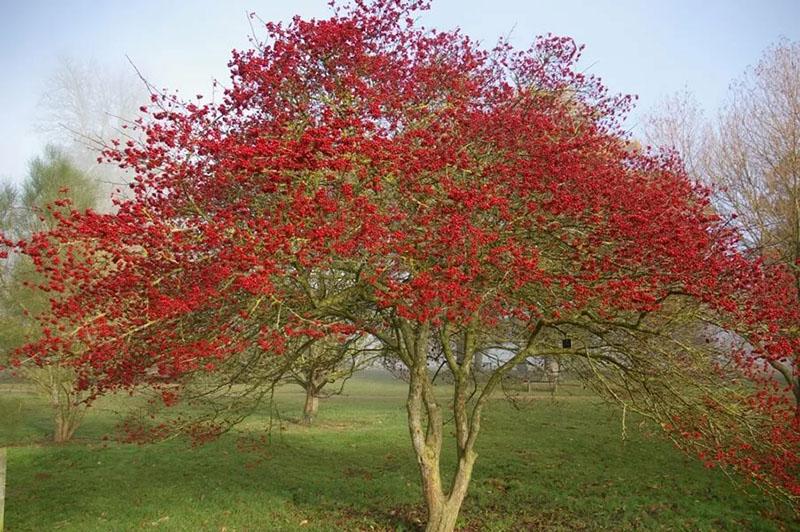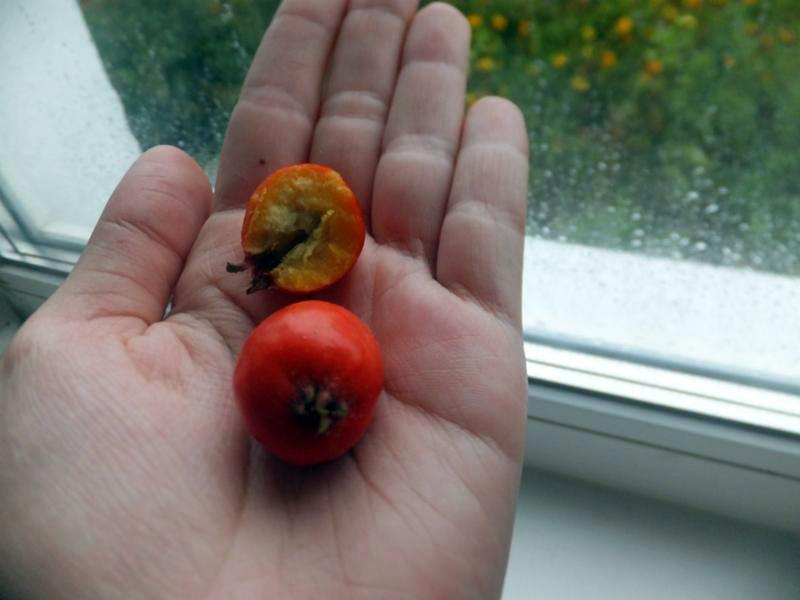How to grow a large and healthy hawthorn - professional advice
 Before growing a hawthorn, you should get acquainted with its features, requirements for soil and watering, and the mode of feeding. This is an unpretentious shrub that easily takes root and grows quickly in meadows and forest edges in a temperate climate. It can be planted in a garden or at a summer cottage, annually to harvest tasty and healthy berries. In addition, hawthorn looks great in landscaping - its fragrant flowers and bright red fruits create unusual decorative accents.
Before growing a hawthorn, you should get acquainted with its features, requirements for soil and watering, and the mode of feeding. This is an unpretentious shrub that easily takes root and grows quickly in meadows and forest edges in a temperate climate. It can be planted in a garden or at a summer cottage, annually to harvest tasty and healthy berries. In addition, hawthorn looks great in landscaping - its fragrant flowers and bright red fruits create unusual decorative accents.
Planting hawthorn

How to plant and grow hawthorn seeds
 One of the ways how to grow hawthorn on the site is seed. This is a simple, but long-term method - from the moment the fruits fall to the germination of seeds, it can take from a year to 4 years. The shell of the seeds of the berries is very dense, so it is recommended to use unripe fruits at home. For their germination, a stratification procedure is required - seed preparation.
One of the ways how to grow hawthorn on the site is seed. This is a simple, but long-term method - from the moment the fruits fall to the germination of seeds, it can take from a year to 4 years. The shell of the seeds of the berries is very dense, so it is recommended to use unripe fruits at home. For their germination, a stratification procedure is required - seed preparation.
It is carried out in two stages, after which the planting material can be planted in open ground.:
- The first stage is the longest, it will take up to 4 months. The seeds are immersed in a peat mixture, moistened and placed in wooden boxes with holes to remove excess water. At the bottom of the boxes there is gauze folded several times. The containers are placed in bright rooms at room temperature (20-25 degrees).
- The second stage lasts from 4 to 7 days, just before planting in open ground. The seeds are harvested in a cold room and kept in water at a temperature of no more than 5 degrees. A cellar or refrigerator is suitable for these purposes.
- Planting seeds in the ground is carried out before winter. To speed up their germination and increase resistance, you can immerse them in a solution of potassium nitrate for a day. Also, the seeds respond positively to organic fertilizers - the hole can be filled with manure or humus. The planting material must be completely submerged in the soil. The first shoots can be seen next spring.
 How quickly a hawthorn grows depends on the type of soil, weather conditions, and other factors. When propagating by seeds, do not expect a quick result. In the first year after planting, the seedlings will not rise more than 10–12 cm.
How quickly a hawthorn grows depends on the type of soil, weather conditions, and other factors. When propagating by seeds, do not expect a quick result. In the first year after planting, the seedlings will not rise more than 10–12 cm.
Planting a hawthorn seedling
 The preferred method for growing hawthorns is with 2 year old seedlings. They can be purchased from nurseries and receive detailed care instructions. They are sold together with a clod of earth and an already formed root system. It is better to plant them in open ground in late autumn, but transplanting is also allowed in early spring, before the start of the growing season.
The preferred method for growing hawthorns is with 2 year old seedlings. They can be purchased from nurseries and receive detailed care instructions. They are sold together with a clod of earth and an already formed root system. It is better to plant them in open ground in late autumn, but transplanting is also allowed in early spring, before the start of the growing season.
Planting seedlings follows a simple algorithm:
- dig a hole or trench about 70 cm deep;

- place a drainage layer up to 15 cm (this can be crushed stone, gravel or other materials);
- add sand in a layer up to 5 cm;
- place the seedling in the hole and gently spread the roots;

- cover the rhizome with earth so that the root collar rises several centimeters above the soil level;
- Water the shrub abundantly and add a large layer of organic fertilizer (compost or manure) on top of the soil.

To grow hawthorn as a fruit shrub, seedlings are placed at a distance of several meters from each other. They can be placed in a common trench to create a hedge.
 Seedlings should be immediately placed on the site where it is planned to grow an adult plant. If you need to move the bushes to another place or plant them at a greater distance from each other, it is better to perform the procedure before 5 years of age. Then the root system of the hawthorn becomes very strong and goes deep into the soil. Digging a plant without damaging the root will not work.
Seedlings should be immediately placed on the site where it is planned to grow an adult plant. If you need to move the bushes to another place or plant them at a greater distance from each other, it is better to perform the procedure before 5 years of age. Then the root system of the hawthorn becomes very strong and goes deep into the soil. Digging a plant without damaging the root will not work.
How to grow your favorite hawthorn variety from a cuttings or cuttings
 If you want to grow a certain variety of hawthorn, you can take a stalk on your favorite bush and germinate it at home. The most effective method, which makes it more likely that a young plant will take root, is the cuttings. These are aerial shoots that root on a plot of land near the mother plant, without separating from it.
If you want to grow a certain variety of hawthorn, you can take a stalk on your favorite bush and germinate it at home. The most effective method, which makes it more likely that a young plant will take root, is the cuttings. These are aerial shoots that root on a plot of land near the mother plant, without separating from it.
 Young annual shoots are suitable as layering. They are placed in small holes dug around the hawthorn and covered with earth. So that they do not rise above the soil surface, they are pressed down with strong fasteners. Further, it is enough to water the cuttings and apply fertilizers according to the schedule of the main plant.
Young annual shoots are suitable as layering. They are placed in small holes dug around the hawthorn and covered with earth. So that they do not rise above the soil surface, they are pressed down with strong fasteners. Further, it is enough to water the cuttings and apply fertilizers according to the schedule of the main plant.
If the procedure is performed in early spring, at the end of the season, the young plant can be separated from the mother plant and transplanted into a separate area.
How to grow hawthorn on your own
 planting it is worth familiarizing yourself with the rules on how to care for a hawthorn. It is important to choose a suitable site where the seedling will grow and develop comfortably. It should be well lit - in nature, bushes do not grow in the shade of trees and prefer sunny edges.
planting it is worth familiarizing yourself with the rules on how to care for a hawthorn. It is important to choose a suitable site where the seedling will grow and develop comfortably. It should be well lit - in nature, bushes do not grow in the shade of trees and prefer sunny edges.
It is also important to follow a few simple rules in order to admire the flowering every year and harvest a rich harvest:
- Watering regime - the plant requires moderate soil moisture. The hawthorn tolerates summer drought and heavy rains. In a typical summer, an adult bush will need a bucket of water per week. During periods of drought, you can water the shrub often, but avoid stagnant moisture and waterlogging of the soil.

- Loosening - this procedure will allow the root system to develop faster and get the maximum nutrients from the soil. After each watering, it is useful to loosen a small area of soil around the trunk to a depth of 15 cm. In winter, the plant is dug to the depth of a shovel.

- Top dressing - hawthorn grows well and develops without fertilization, but they will help increase resistance to various diseases. In addition, only one top dressing is needed per season, before the beginning of the flowering period. Hawthorn responds well to organic fertilizersso it is useful to water it with a diluted barn or compost solution.

- Pruning hawthorns in spring can be sanitary and formative, both types are carried out before the beginning of the growing season. At the first, dry, non-viable shoots, as well as areas damaged by various diseases are removed. For the formation of bushes, up to 5–6 main trunks are left and branches are periodically cut off, thereby stimulating the growth of lateral shoots. For a hedge, in the first few years of life, you can trim to half of last year's growth, and then maintain a plant height of 70 cm.

Seedlings can be transplanted into open ground in both spring and autumn. However, replanting hawthorns in autumn is preferable, as is the case for many fruit trees and berry bushes.
Shrub diseases and pests
 Hawthorn pests and control of them is an important task that will help keep the shrub large and healthy.The plant exhibits a high degree of resistance to various diseases, but can also be damaged by fungi, bacteria, insects and their larvae.
Hawthorn pests and control of them is an important task that will help keep the shrub large and healthy.The plant exhibits a high degree of resistance to various diseases, but can also be damaged by fungi, bacteria, insects and their larvae.
The list of the most dangerous diseases includes:
- powdery mildew - fungal infection, from which the leaves of the hawthorn are curled, a light bloom appears on the shoots;
- various types of spotting (ocher, white, gray, brown) - a complex of fungal diseases in which spots of different shapes, sizes and colors form on the leaves and shoots;
- green aphid is a pest that feeds on the juice of young shoots and leads to their drying out;
- hawthorn - a butterfly that feeds on flower nectar, and its larvae destroy leaves and buds;
- rose leafworm - this pest lays eggs under the bark of the plant.
 Chemical solutions are used to control certain types of diseases and pests. Karbofos, Chlorofos, Vectra and other drugs are presented in specialized stores, indicating the dosage, schedule and method of application. Bordeaux mixture - a solution of copper sulfate with the addition of gypsum - helps well against fungal diseases.
Chemical solutions are used to control certain types of diseases and pests. Karbofos, Chlorofos, Vectra and other drugs are presented in specialized stores, indicating the dosage, schedule and method of application. Bordeaux mixture - a solution of copper sulfate with the addition of gypsum - helps well against fungal diseases.
At the first signs of disease damage to the plant, the damaged shoots should be urgently removed, capturing healthy areas. This will help prevent further spread of the pathogen over the surface of the bush.
When pruning in the fall, it is necessary to get rid of old and dry branches - they are often the target of various infectious diseases.
Hawthorn in landscape design
 A well-groomed hawthorn in the house area is an unusual element that will attract attention. With the help of pruning, you can form an even crown of a round or square shape, as well as create a hedge.
A well-groomed hawthorn in the house area is an unusual element that will attract attention. With the help of pruning, you can form an even crown of a round or square shape, as well as create a hedge.  At the end of spring, the period of its flowering begins. White, very fragrant flowers bloom densely on the shoots.
At the end of spring, the period of its flowering begins. White, very fragrant flowers bloom densely on the shoots.  From the end of summer until the very frost, red berries appear on the bush, which will give bright accents to the winter garden.
From the end of summer until the very frost, red berries appear on the bush, which will give bright accents to the winter garden.
There are many options for what to plant next to the hawthorn. It looks spectacular in multi-level plantings with other shrubs, annual and perennial flowers. However, he cannot be in the shade of trees and taller bushes.  The hawthorn should remain the highest point in the composition and be located away from the shadows. If you take into account the rules for planting, growing and caring for it, regularly trim the crown - it will have a decorative appearance and will decorate any site.
The hawthorn should remain the highest point in the composition and be located away from the shadows. If you take into account the rules for planting, growing and caring for it, regularly trim the crown - it will have a decorative appearance and will decorate any site.